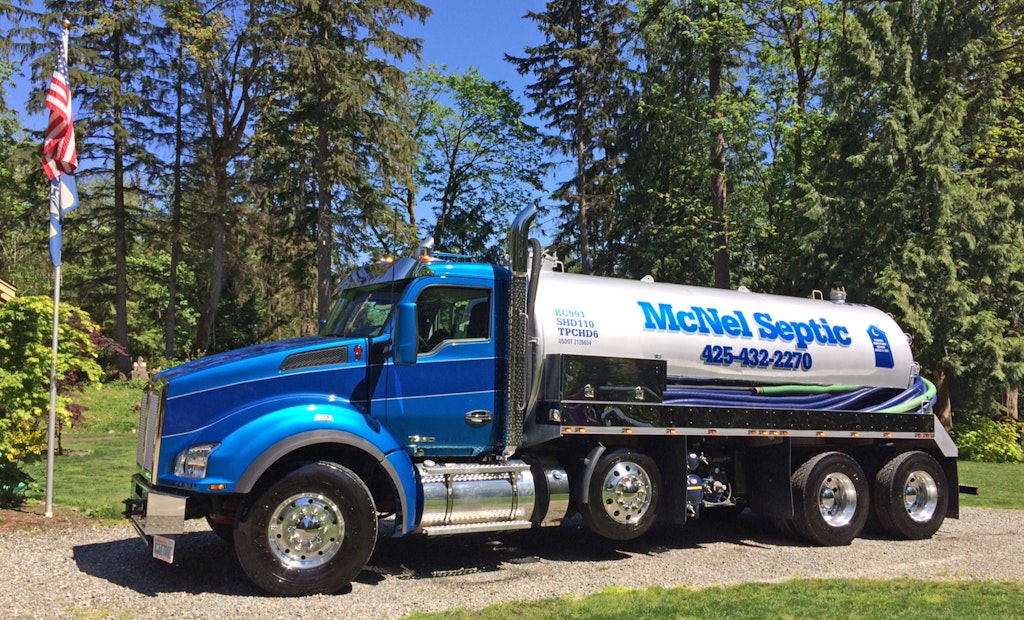Interested in Industrial?
Get Industrial articles, news and videos right in your inbox! Sign up now.
Industrial + Get AlertsWho says you can’t always get what you want? Shawn Carlton got what he wanted and needed in his 2016 Kenworth T880 built out by Erickson Tank & Pump.
Carlton, the owner of McNel Septic Service of Ravensdale, Washington, says he specced out the truck from Kenworth and worked with Erickson on exactly what he wanted out of the body. “For our last truck, we flew across the U.S. to buy a used one, and it just was not what we wanted. That’s how ultimately we ended up buying something new — to spec it out exactly how we need it — and we know the history of the vehicle. That’s huge.”
Putting practicality first
Carlton focused on practicality and longevity when speccing out the Kenworth, which was the driving force behind choosing a steel tank. “The aluminum is nice, and there’s pros and cons with both of them, but just talking to my tank builder, it was a little cheaper to go steel, and he told me it would last a heck of a lot longer than an aluminum tank, so that’s why I went with that,” says Carlton.
He chose a 4,000-gallon tank for efficiency to cut down on the number of trips to a disposal facility, but the tradeoff was maneuverability. “This truck is difficult to maneuver,” he says. “You really have to set yourself up in your turns because it’s such a long-wheelbase truck to have it legal on all your axles with that steel tank.
An aluminum tank wouldn’t be as long. “It would be way, way easier to get into places, but that’s why I carry a lot of hose, because I know I can’t get into a lot of tight driveways.”
With 300 feet of hose, it’s enough compensation for the truck’s challenging maneuverability. “Do I use it all? No, but it’s on there,” says Carlton. “It’s better to have too much. I bet the most I’ve ever pulled was 250 feet at the max.”
Unlike the tank tradeoff of capacity and efficiency in exchange for navigating tight driveways, sometimes practicality and ease of use match up perfectly. Case in point: the truck’s automatic transmission. “At first I was kind of skeptical about it, but now after driving it, I don’t think I would ever go back to a manual,” Carlton says. “One, you or whoever else is driving it can focus more on driving. I mean, it’s like a pickup. It’s really simple — just put it in D and go. Or, if you hire someone new, they’re not beating the heck out of your truck trying to shift. It’s just all-around an easy truck to drive. I love the automatic.”
Factoring in a hilly terrain
Carlton opted for a three-stage jake brake and full-locking rears to handle the area’s sloping topography. “The three-stage jake is an engine brake, so it helps you when you’re going down hills,” he says. “You don’t have to hit your brakes, so your brakes don’t get hot — it’s all compression. If you’re empty and you have it on the third stage, it really slows down fast, so you can adjust it to a different stage if you don’t want it to slow itself down. The third setting is nice when you’re going down a steep grade and you’re full. You can maintain your speed or it slows down on its own without getting your brakes hot.”
The full-locking rears are the truck’s insurance against getting stuck, because as Carlton points out, “Tow trucks are expensive.”
Driving pumper trucks in Washington is all about topography. “Some of these driveways and roads you need to go up, you need all four rear tires turning. So we specifically specced out a full-locking rear. Some trucks you can go with just one set of the duallys in the rear spinning, but we wanted all four.”
But Carlton doesn’t just rely on the full-locking rears to keep his truck rolling. “Our policy is try to stay on asphalt or gravel. Don’t ever go off into the grass or into the dirt, because you just don’t know,” he says. “It’s been a wet winter, so there have been a few times that I’ve had to use those locks. I’ve tried just the front and it still spins, but when I went fully, I’ve been able to crawl out.”
A decked-out Kenworth
Just because Carlton relied on practicality and functionality when speccing out the truck doesn’t mean he didn’t have a little fun with the paint job and cab interior, down to a wood-grain dash. “We got every option we could for the truck. It’s even got heated seats in it, full-on navigation, MP3, all that good stuff.”
As for choosing the color scheme, he says he likes older Chevelle colors and liked the blue metallic color in the Kenworth paint catalogue.
“I’ve always loved that-color blue,” says Carlton. “So we got that and I just started comparing paint samples of other blues, and I thought the darker blue complemented it perfectly. That’s how we landed on it, and then Kenworth presented doing the silver pinstripe, which blends into the silver tank color just about perfectly, so it all just came together very well.”






